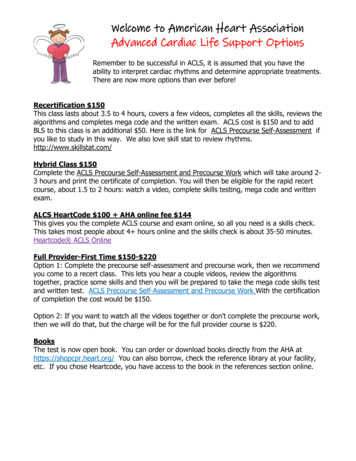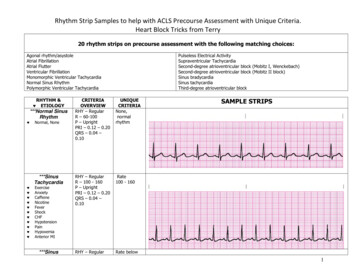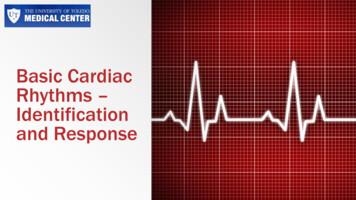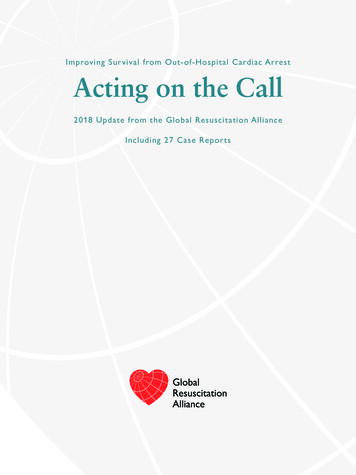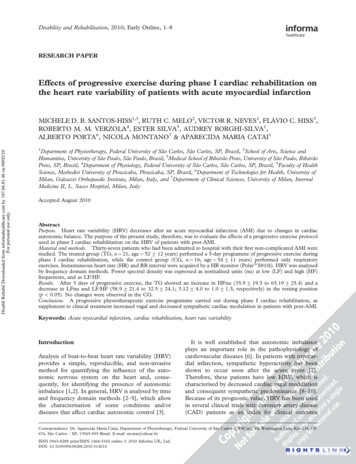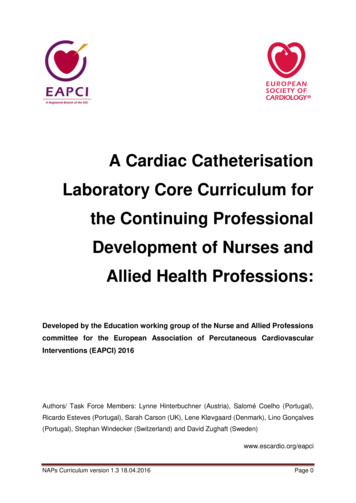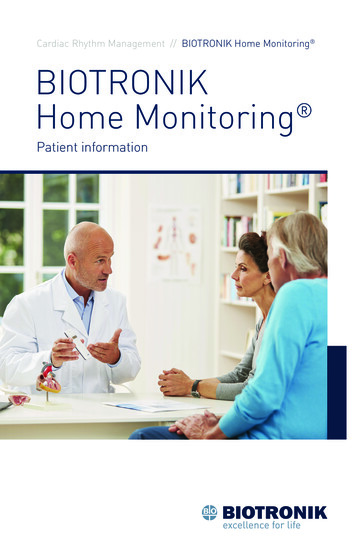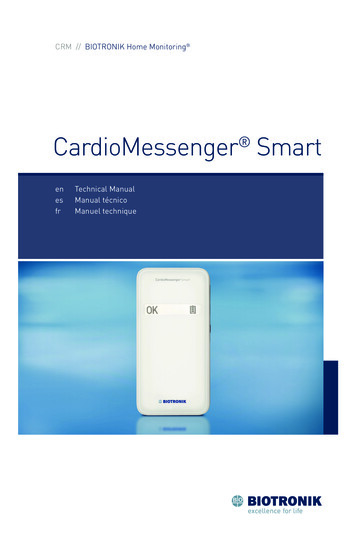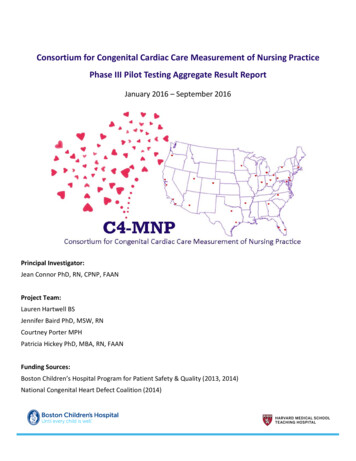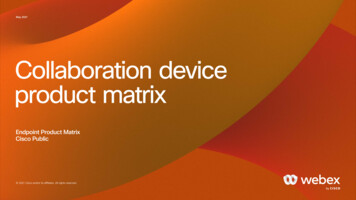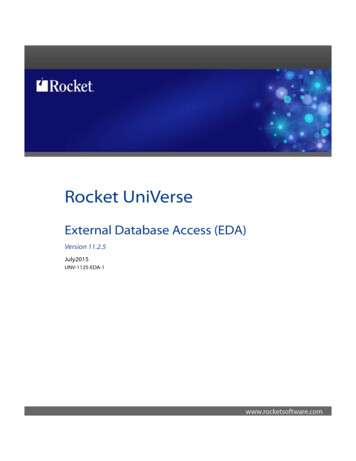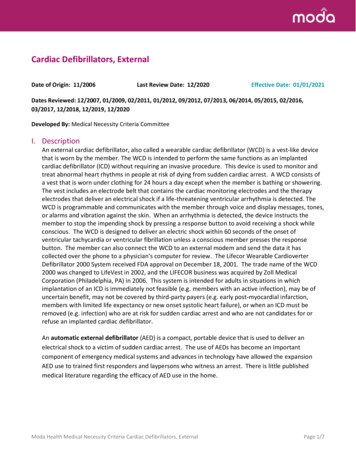
Transcription
Cardiac Defibrillators, ExternalDate of Origin: 11/2006Last Review Date: 12/2020Effective Date: 01/01/2021Dates Reviewed: 12/2007, 01/2009, 02/2011, 01/2012, 09/2012, 07/2013, 06/2014, 05/2015, 02/2016,03/2017, 12/2018, 12/2019, 12/2020Developed By: Medical Necessity Criteria CommitteeI. DescriptionAn external cardiac defibrillator, also called a wearable cardiac defibrillator (WCD) is a vest-like devicethat is worn by the member. The WCD is intended to perform the same functions as an implantedcardiac defibrillator (ICD) without requiring an invasive procedure. This device is used to monitor andtreat abnormal heart rhythms in people at risk of dying from sudden cardiac arrest. A WCD consists ofa vest that is worn under clothing for 24 hours a day except when the member is bathing or showering.The vest includes an electrode belt that contains the cardiac monitoring electrodes and the therapyelectrodes that deliver an electrical shock if a life-threatening ventricular arrhythmia is detected. TheWCD is programmable and communicates with the member through voice and display messages, tones,or alarms and vibration against the skin. When an arrhythmia is detected, the device instructs themember to stop the impending shock by pressing a response button to avoid receiving a shock whileconscious. The WCD is designed to deliver an electric shock within 60 seconds of the onset ofventricular tachycardia or ventricular fibrillation unless a conscious member presses the responsebutton. The member can also connect the WCD to an external modem and send the data it hascollected over the phone to a physician’s computer for review. The Lifecor Wearable CardioverterDefibrillator 2000 System received FDA approval on December 18, 2001. The trade name of the WCD2000 was changed to LifeVest in 2002, and the LIFECOR business was acquired by Zoll MedicalCorporation (Philadelphia, PA) in 2006. This system is intended for adults in situations in whichimplantation of an ICD is immediately not feasible (e.g. members with an active infection), may be ofuncertain benefit, may not be covered by third-party payers (e.g. early post-myocardial infarction,members with limited life expectancy or new onset systolic heart failure), or when an ICD must beremoved (e.g. infection) who are at risk for sudden cardiac arrest and who are not candidates for orrefuse an implanted cardiac defibrillator.An automatic external defibrillator (AED) is a compact, portable device that is used to deliver anelectrical shock to a victim of sudden cardiac arrest. The use of AEDs has become an importantcomponent of emergency medical systems and advances in technology have allowed the expansionAED use to trained first responders and laypersons who witness an arrest. There is little publishedmedical literature regarding the efficacy of AED use in the home.Moda Health Medical Necessity Criteria Cardiac Defibrillators, ExternalPage 1/7
II. Criteria: CWQI HCS-0014AA. Moda Health will cover an FDA approved wearable cardiac defibrillator (WCD) when ALL theserequirements are met:a. The member is at high risk for sudden cardiac deathb. Member has had a face-to-face examination within 6 months prior to the requestc. The member meets eligibility for an implantable cardiac defibrillator (ICD)d. The member is an adult, 18 years of age or oldere. The member has completed electrophysiologic studies to determine the type of arrhythmiapresent and confirm that an automatic cardiac defibrillator is the best course of treatmentand 1 or more of the following criteria is met:i. The member has a hereditary condition with high risk incidence of ventriculartachyarrhythymias such as long QT syndrome or hypertropic cardiomyopathyii. A documented episode of VF, or a sustained (lasting 30 seconds or longer) VT; (thesedysrhythmias may be either spontaneous or induced during an EP (electrophysiologystudy), but may not be due to a transient or reversible cause and not occur duringthe first 48 hours of an acute myocardial infarction (AMI).iii. The WCD is being used temporarily until the member receives a heart transplant ofICDiv. The member is not a suitable candidate for an ICDv. The WCD is being used post MI as a bridge during the first 40 days post event whilewaiting for an ICD with a history of 1 or more of the following:1. Ventricular tachycardia or ventricular fibrillation in the first 48 hours postinfarct2. Reduced Left ventricular ejection fraction (LVEF) of less than or equal to 35vi. The member refuses ICD placementvii. The member has a systemic infection or other temporary condition that precludesICD implantation.f. The requested WCD is for no more than 3 months or after 3 months, a new request issubmitted with additional clinical documentation*Note – WCDs (i.e. Zoll LifeVest) are intended for short-term use. If approved, the WCD will be rented ona monthly basis. If the rental cost exceeds the cost of purchase for longer term use, purchase of the WCDwill be considered.B. Non-wearable automatic external defibrillators (AED) for adults (age 18 and older) are consideredinvestigational for home use. There are few peer-reviewed published studies that report on clinicaloutcomes of AEDs used in the home setting for adults by lay persons, and no studies that evaluatethe efficacy of AEDs in reducing mortality compared to alternatives (i.e. ICD or emergencytreatment by first responders).a. Refer to Noridian L33690 for Medicare coverage requirementsMedicare Reference:LCD: L33690Moda Health Medical Necessity Criteria Cardiac Defibrillators, ExternalPage 2/7
III. Information Submitted with the Prior Authorization Request:1.2.3.4.History and physical from treating physicianResults for electrophysiology studiesPatient contraindication to ICDAnticipated length of time that WCD will be usedIV. Applicable CPT or HCPC codes covered:CodesDescription93292Interrogation device evaluation (in person) with analysis, review and report by a physicianor other qualified health care professional, includes connection, recording anddisconnection per patient encounter; single, dual, or multiple lead pacemaker system, orleadless pacemaker system; wearable defibrillator systemInitial set-up and programming by a physician or other qualified health care professionalof wearable cardioverter-defibrillator includes initial programming of system, establishingbaseline electronic ECG, transmission of data to data repository, patient instruction inwearing system and patient reporting of problems or eventsWearable, automatic, EXTERNAL DEFIBRILLATORs with integrated electrocardiogramanalysisReplacement battery for automated external defibrillator, garment type onlyReplacement garment for use with automated external defibrillatorReplacement electrodes for use with automated external defibrillator, garment type only93745K0606K0607K0608K0609V. CPT or HCPC codes NOT covered:CodesDescriptionE0617Non wearable automatic EXTERNAL DEFIBRILLATORS with integrated electrocardiogramcapabilityVI. Annual Review HistoryReview DateRevisionsEffective Date07/2013Annual Review: Added table with review date, revisions, and effectivedate.Annual Review: Moved criteria of hereditary condition as one or moreof the following; added purchase if rental cost exceeds purchase price.Annual Review: Corrected the manufacturer to Zoll. Added I.B Face toface exam per CMS guideline. Added Medicare LCD reference. AddedI.E.h – additional clinical documentation submitted after 3 mos. AddedICD-9 codes per CMS guideline07/201306/201405/2015Moda Health Medical Necessity Criteria Cardiac Defibrillators, External06/201405/2015Page 3/7
02/2016Updated criteria, ICD-10 codes, removed AED criteria and removed ICD- 02/24/20169 codes03/2017Annual Review: Added criteria A.e.ii and A.e.vii, updated reference toMedicare guidelineAnnual Review: Updated reference to Medicare LCDAnnual Review: No changesAnnual Review: Grammar updates. No content 1901/01/202001/01/2021References1. Barclay L. LIFEPAK 500 AED accurate in infants and children. Ann Emerg Med. 2003;42:185-196.2. Cecchin D, Jorgenson D, Berul C, et al. Is arrhythmia detection by automatic externaldefibrillator accurate for children? Sensitivity and specificity of an automatic externaldefibrillator algorithm in 696 pediatric arrhythmias. Circulation 2001;103;2483-2488.3. Cram P, Katz D, Vijan S, et al. Implantable or external defibrillators for individuals at increasedrisk of cardiac arrest: where cost-effectiveness hits fiscal reality. Value Health. 2006 SepOct;9(5):292-302.4. Divekar A, Soni R. Successful parental use of an automated external defibrillator for an infantwith long-QT syndrome. Pediatrics. June 2006. (doi:10.1542/peds.2006-0129).5. Feldman AM, Klein H, Tchou P, et al. Use of a wearable defibrillator in terminatingtachyarrhythmias in patients at high risk for sudden death: results of the WEARIT/BIROAD.Pacing Clin Electrophysiol. 2004 Jan;27(1):4-9.6. HAYES alert newsletter. Technology Assessment Brief. Wearable Cardioverter Defibrillator.Lansdale, PA: HAYES, Inc.; 2002 Winifred S. Hayes, Inc. 2002 Dec V(12).7. International liason committee on resuscitation lowers the bar on use of AEDrecommendations-approves use in children 1 to 8 years of age. Accessed on February 7, 2011at: http://www.medscape.com/viewarticle/458298.8. Martinez-Rubio A, Baron-Exquivias G. The automatic external cardioverter-defibrillator. IndianPacing Electrophysiol J. 2004 Jul 1;4(3):114-21.9. Infant/Child Reduced Energy Defibrillation Electrodes Instruction for Use.Medtronic 2005; 1-11.10. Reek S, Geller JC, Meltendorf U, et al. Clinical efficacy of a wearable defibrillator in acutelyterminating episodes of ventricular fibrillation using biphasic shocks. Pacing Clin Electrophysiol.2003 Oct;26(10):2016-22.11. Reek S, Geller JC, Meltendorf U, et al. Clinical efficacy of a wearable defibrillator in acutelyterminating episodes of ventricular fibrillation using biphasic shocks. Pacing Clin Electrophysiol.2003 Oct;26(10):2016-22.12. Reek S, Meltendorf U, Geller JC, et al. The wearable cardioverter defibrillator (WCD) for theprevention of sudden cardiac death-a single center experience. Z Kardiol. 2002Dec;91(12):1044-52.13. Samson R, Berg R, Bingham R. Use of automated external defibrillators for children: an updatean advisory statement from the pediatric advanced life support task force, international liaisoncommittee on resuscitation. Pediatrics. 2003; 112:163-168.Moda Health Medical Necessity Criteria Cardiac Defibrillators, ExternalPage 4/7
14. Sanna T, Fedele F, Genuini I, et al. Home defibrillation: a feasibility study in myocardialinfarction survivors at intermediate risk of sudden death. Am Heart J. 2006 Oct;152(4):685.e1-7.15. Schott R. Wearable defibrillator. J Cardiovasc Nurs. 2002 Apr;16(3):44-52.16. Klein HU, Meltendorf U, Reek S, et al. Bridging a temporary high risk of sudden arrhythmicdeath. Experience with the wearable cardioverter defibrillator (WCD). Pacing Clin Electrophysiol2010; 33:353.17. Centers for Medical Coverage; Noridian Healthcare Solutions, LLC (19003); Local CoverageDetermination (LCD) Automatic External Defibrillators (L33690); Original Effective Date10/1/2015, Revision Effective Date 07/01/201618. UpToDate, Chung, Mina K, MD; Wearable cardioverter-defibrillator; Feb 2017.19. Physician AdvisorsAppendix 1 – Covered Diagnosis CodesICD-10ICD-10 DescriptionB57.0Acute Chagas' disease with heart involvementB57.2Chagas' disease (chronic) with heart involvementD86.9Sarcoidosis, unspecifiedI25.3Aneurysm of heartI25.5Ischemic cardiomyopathyI25.89Other forms of chronic ischemic heart diseaseI25.9Chronic ischemic heart disease, unspecifiedI40.0Infective myocarditisI40.1Isolated myocarditisI42.1Obstructive hypertrophic cardiomyopathyI42.2Other hypertrophic cardiomyopathyI42.5Other restrictive cardiomyopathyI42.6Alcoholic cardiomyopathyI42.7Cardiomyopathy due to drug and external agentI42.8Other cardiomyopathiesI43Cardiomyopathy in diseases classified elsewhereI45.81Long QT syndromeModa Health Medical Necessity Criteria Cardiac Defibrillators, ExternalPage 5/7
ICD-10ICD-10 DescriptionI45.89Other specified conduction disordersI46.9Cardiac arrest, cause unspecifiedI47.2Ventricular tachycardiaI49.01Ventricular fibrillationI49.02Ventricular flutterI50.1Left ventricular failureI50.20Unspecified systolic (congestive) heart failureI50.22Chronic systolic (congestive) heart failureI50.23Acute on chronic systolic (congestive) heart failureI50.9Heart failure, unspecifiedR55Syncope and collapseT82.6XXAInfection and inflammatory reaction due to cardiac valve prosthesis, initialencounterT82.7XXAInfection and inflammatory reaction due to other cardiac and vascular devices,implants and grafts, initial encounterT82.817AEmbolism of cardiac prosthetic devices, implants and grafts, initial encounterT82.827AFibrosis of cardiac prosthetic devices, implants and grafts, initial encounterT82.837AHemorrhage of cardiac prosthetic devices, implants and grafts, initial encounterT82.847APain from cardiac prosthetic devices, implants and grafts, initial encounterT82.857AStenosis of cardiac prosthetic devices, implants and grafts, initial encounterT82.867AThrombosis of cardiac prosthetic devices, implants and grafts, initial encounterT82.897AOther specified complication of cardiac prosthetic devices, implants and grafts,initial encounterT82.9XXAUnspecified complication of cardiac and vascular prosthetic device, implant andgraft, initial encounterZ76.82Awaiting organ transplant statusZ82.41Family history of sudden cardiac deathModa Health Medical Necessity Criteria Cardiac Defibrillators, ExternalPage 6/7
ICD-10ICD-10 DescriptionZ86.74Personal history of sudden cardiac arrestZ97.810Presence of automatic (implantable) cardiac defibrillatorAppendix 1 – Centers for Medicare and Medicaid Services (CMS)Medicare coverage for outpatient (Part B) drugs is outlined in the Medicare Benefit Policy Manual (Pub. 100-2),Chapter 15, §50 Drugs and Biologicals. In addition, National Coverage Determination (NCD) and Local CoverageDeterminations (LCDs) may exist and compliance with these policies is required where applicable. They can befound at: ch/advanced-search.aspx. Additionalindications may be covered at the discretion of the health plan.Medicare Part B Covered Diagnosis Codes (applicable to existing NCD/LCD):Jurisdiction(s): D (DME)NCD/LCD Document (s):Local Coverage Determination (LCD): Automatic External Defibrillators (L33690)NCD/LCD Document 0703/7218263/Automatic External e accessed: 12/11/2018Medicare Part B Administrative Contractor (MAC) JurisdictionsJurisdictionF (2 & 3)Applicable State/US TerritoryAK, WA, OR, ID, ND, SD, MT, WY, UT, AZModa Health Medical Necessity Criteria Cardiac Defibrillators, ExternalContractorNoridian Healthcare Solutions, LLCPage 7/7
collected over the phone to a physician’s computer for review. The Lifecor Wearable ardioverter Defibrillator 2000 System received FDA approval on December 18, 2001. The trade name of the WCD 2000 was changed to LifeVest in 2002, and the LIFECOR business was acquired by Zoll

